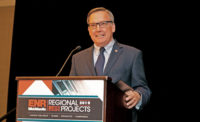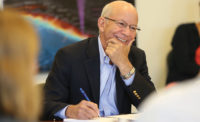Two decades ago, the American Council of Engineering Companies’ annual convention looked more like an old-style wedding than an event from the hard-edged trade association and smoothly running lobbying machine the ACEC is today. Back in the day, the convention consisted of the organization’s volunteer leadership dressed in tuxedos on stage with their wives—who also held organizational positions—“while the rest of the members sat in the audience; it was the strangest thing,” recalls David A. Raymond, who retired in July as ACEC’s president and chief executive after 20 years of service. Despite holding demanding senior positions at engineering firms, the volunteer leaders controlled all aspects of ACEC. For example, the treasurer “dictated to the staffers how the books should be kept,” Raymond says. “We cleared all that out. We just bulldozed all these vestiges of some earlier day that was no longer the way a modern business association should function.”
Raymond set out to turn what he calls the de facto “social club” into a “hard-hitting fighting group on the legislative front.” He started by elevating existing staffers from “note takers and arrangers of tea and coffee” to leadership roles. He compensated them accordingly, too.
Raymond’s efforts ultimately resulted in ACEC becoming “a known force in Washington,” says Terry F. Neimeyer, former ACEC chairman and current chairman of KCI Technologies Inc. In addition to making ACEC a more “business-friendly organization,” Neimeyer says Raymond “found ways to educate our members on all of the good things that ACEC does to add value to our firms.”
Raymond says the association doubled its budget under his watch.
“The point of being a member of ACEC is to contribute to and benefit from a winning advocacy organization.”
– David A. Raymond, Former President and Chief Executive, ACEC
Today, it ranks in the top 3% of all federal political action committees with more than $1 million in annual contributions. ACEC member firms account for 87% of the 2018 ENR Top 500 Design Firms, up from 70% a decade earlier. In addition, 90% of the ENR Top 100 belong to ACEC. Today, the council has more than 5,600 member firms in 52 state and regional chapters. Those firms represent more than 600,000 industry professionals, up from approximately 100,000 several years earlier.
Raymond has injected life into ACEC’s events. Attendance at its annual convention rose 35%, to more than 1,500, over the last six years. In 2006, then-President George W. Bush headlined the convention. Other past speakers include writers Doris Kearns Goodwin and David McCullough and former Central Intelligence Agency and National Security Agency leader Michael Hayden. Once a sleepy 150-person luncheon, ACEC’s annual Engineering Excellence Awards now draws more than 750 attendees annually. Actor-comedian Kevin Nealon hosted the event the last two years.
The 70-year-old Raymond “has truly left a legacy of achievement and accomplishment,” Mary Ann Emely, senior adviser at ACEC, said while introducing Raymond as ENR MidAtlantic’s 2018 Legacy Award winner on Nov. 7 in Baltimore.
Taking the Hill
When it comes to lobbying for legislative and regulatory issues, Raymond is a staunch subscriber to the Vince Lombardi theory that “Winning isn’t everything, it’s the only thing.” Without a record of success on Capitol Hill, ACEC would dissolve, he says. “The point of being a member of ACEC is to contribute to and benefit from a winning advocacy organization,” he says.
In 2004, while lobbying for the American Jobs Creation Act, ACEC convinced Congress to include engineering firms among those that could take a 9% deduction for domestic manufacturing companies working abroad. “Dave is a strategic thinker and was a great advocate for his members,” says Steve Sandherr, chief executive of the Associated General Contractors of America.
In 2006, Raymond was part of a coalition of 100 business organizations lobbying for the repeal of a law requiring engineering firms and contractors—among other federal government clients—to have 3% of their payments withheld. After five years, the withholding was eliminated, saving ACEC member firms “millions in cash flow that was going to be withheld by the U.S. government,” Neimeyer says.
More recently, Raymond and ACEC lobbied for the 2017 Tax Cuts and Jobs Act. The council convinced lawmakers to include a provision that allows engineering firms organized as pass-through entities to receive a 20% tax deduction. The provision, which was not part of an earlier version of the legislation, benefits S corporations, partnerships and LLCs. Noting that other groups, such as accountants, lawyers and entertainers, didn’t get the 20% deduction, Raymond says, “It really was quite a victory for us.”
While ACEC often works with other like-minded organizations to lobby for, or against, legislation, Raymond says ACEC had to lead on the 2017 Tax Cuts and Jobs Act because “other industries are not tied to the qualifications-based selection (QBS) doctrine that ACEC has promoted over the years.”
In an effort to defend QBS challenges from the likes of the Federal Emergency Management Agency and the U.S. Forest Service, ACEC says it has stopped state transportation departments throughout the years from bidding projects in so-called reverse auctions. One of ACEC’s biggest victories under Raymond’s leadership was in 2005 when the organization helped secure legislation to restrict state DOTs from imposing caps on firms’ overhead. The legislation also included uniform procurement rules for federally funded transportation projects. Separately, ACEC achieved victories in the states by rebuffing efforts to make it more difficult for state governments to outsource engineering services.
All this work at the state level played into Raymond’s concerted effort to improve relations between the national ACEC office and its state chapters. Raymond beefed up ACEC’s dollar-for-dollar matching program between the national organization and the member chapters by helping to generate more total dollars raised from member firms.
That helped secure legislative, regulatory and judiciary wins at the state level, Raymond says. Additionally, Raymond led an effort to uniformly rename and rebrand the member organizations to incorporate “ACEC” into their chapter titles. For example, the Texas Civil Engineering Consultants became ACEC/Texas. “When you go out on the field and you’ve all got the same uniform instead of wearing different uniforms, that does a lot for cohesion in an organization,” Raymond says.
Raymond credits his staff for these successes. He says he championed their efforts by participating in their work without micromanaging. “I wanted our advocacy staff to manage itself and run itself, but I also wanted to participate with them to provide whatever insight, support and so forth I could,” he says. “Because I couldn’t let them fail. Nobody was allowed to fail.”
Arrival
Born in Frankfurt, Germany, in 1948, Raymond spent the first 10 years of his life in post-War Europe while his father, a World War II veteran, worked as a foreign correspondent for The New York Times. He moved to Washington, D.C., when his father was assigned to the Times’ Washington bureau.
After graduating from Princeton and receiving a master’s degree from Tufts University’s Fletcher School of Law and Diplomacy, Raymond got a law degree from Georgetown, attemding classes at night while working days. Early in his career, Raymond served as assistant to the administrator of the U.S. Agency for International Development and was a defense and foreign policy adviser to former U.S. Senator Stuart Symington, a Missouri Democrat. Raymond also worked as an assistant dean at Georgetown University’s School of Foreign Service before becoming a senior executive at firms such as Raytheon Engineers & Constructors Inc. and EBASCO Services International Inc., an international arm of the engineering and construction giant EBASCO Services Inc. “It was quite an impressive background that he brought to ACEC,” Emely said at the awards luncheon.
Though Raymond’s construction and congressional background seemed to suit him for his role at ACEC, he didn’t feel that the organization reached “a point of arrival” until he got a call from Karl Rove early in President George W. Bush’s first term. Rove, then a senior adviser to the president, was impressed by ACEC’s success on Capitol Hill. He attended a meeting at ACEC’s office along with heads of other leading trade associations, Raymond says. The meeting eventually led to Bush’s address to ACEC’s annual convention in 2006.
ACEC’s events have also become much more “hard-core business” focused, Raymond says, and they also provide members the opportunity to receive credits toward their engineering licenses. Other education initiatives include in-person and online seminars, as well as popular executive education programs focused on financial topics. ACEC says several of its specialized coalitions and forums are attended by 10,000 members annually from 1,250 member firms.
Unfinished Business
Getting major infrastructure legislation enacted is one of Raymond’s biggest pieces of unfinished ACEC business. “We’re running behind in that area, and we need to catch up badly,” he says. “Even when we receive modest [funding] increases periodically, we shouldn’t be satisfied with that, because the need is so much greater.”
But Raymond says he is finished wading into legislative battles. He is preparing to move from the Washington, D.C., area to Florida with his wife later this year, and says he has no interest in consulting or joining industry boards. A bookworm, Raymond says he reads three times as much as he did while he was working, including three books in one recent week-and-a-half stint. He also might try his hand at teaching a course in history or business. “I loved everything that I was doing,” he says of his time at ACEC. “I’m just moving on to a new phase—as I’ve done before—in my life.”






